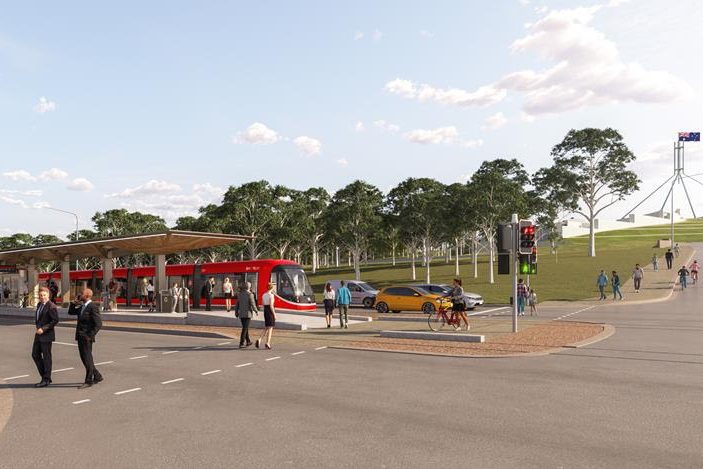
Former planner MIKE QUIRK looks at the past and the future for Tuggeranong as its first suburb, Kambah, turns 50.
Fifty years ago settlement in Tuggeranong began in Kambah.

Tuggeranong was the third new-town developed by the National Capital Development Commission (NCDC) following Woden-Weston Creek and Belconnen.
Activities were located in the context of a centre’s hierarchy – major office employment and higher-order services and facilities and at Civic and the town centres; group centres, locations of major supermarkets and services and facilities serving a group of suburbs and neighbourhoods with primary schools and facilities meeting day-to-day needs.
Tuggeranong represented the ongoing development of high quality suburban development with the early provision of services and facilities, quality open space and transport connections and significant local employment assisted by Canberra’s office-centric employment structure.
It avoided the unco-ordinated sprawl found in other Australian cities. Its planning worked within the community’s preference for low-density housing and the car.
Hugh Stretton’s Ideas for Australian Cities (1970) and the NCDC’s Tomorrow’s Canberra (1970) outline Canberra’s then exemplary planning and development.
In Kambah and Wanniassa the centres’ hierarchy was modified with Territorial Units replacing neighbourhoods in the expectation they would be more adaptable to social and demographic changes.
Like the other new-towns, settlement in Tuggeranong was dominated by young households with dependents.
Due to the government’s ownership of land, unlike other Australian cities, growth was concentrated to a limited number of locations enabling the early provision of schools, shops and other facilities. This concentration has a long-term downside as it results in a more rapid decline in population as the area ages.
By 1996 the District’s population was over 91,000. By 2016 it had fallen to 85,200. It has since increased to over 89,000.
In 2001, 26.8 per cent of the population of Tuggeranong were aged 0 to 14 years. By 2021 the share in this cohort had declined to 19.2 per cent. Correspondingly, the population aged 65 years and over increased from 4.4 to 15.6 per cent. The changing demography contributed to the closure of schools and an increased demand for services and facilities for older residents.
Much has changed since the initial design and settlement of Tuggeranong and the other new towns.
Greater awareness of the environmental impacts of development, climate change, fire risks, social changes including increased workforce participation of women, reduced family size, reduced housing affordability, changed shopping patterns, increased working from home and an increased preference for higher-density housing in areas of high accessibility.
What is striking about Canberra’s suburbs is that they have good “bones”, which will make their adjustment to the parameters now shaping city development easier than many areas.
Their design includes good pedestrian, cycle and open-space networks, sites for a variety of housing, centres and schools in proximity to homes (albeit not as effective as when originally planned given demographic and social changes) and road systems that reduce traffic intrusion.
The ACT District Population Projections 2020 to 2060 indicate the population of Tuggeranong will stabilise near its current level. The projections appear pessimistic if the experience of Kambah is a guide. The projections projected a 2023 population of 15,200 (down from 18,400 in 1991) and a decline to 14,070 by 2033. Yet the latest ABS (2023) estimate is 15,760.
In 2021, there were 34,469 dwellings in the District of which almost 80 per cent were separate dwellings. Despite the number of dwellings in Tuggeranong increasing by 1850 between 2016 and 2021, the ACT government’s District strategy forecasts a demand for an additional 1100 dwellings between 2022 and 2060.
The population increase is likely to be higher as small, older households are replaced by younger households, from dual occupancies and the uptake of medium-density and higher-density housing at centres and at nodes on transport routes.
The high-quality environment could be increasingly attractive to those seeking more affordable housing and who do not wish/need (through the ability to work from home) to live in an increasingly congested inner city. Additional employment and improved transport connections would also increase demand.
The potential of west Murrumbidgee (planned to accommodate more than 40,000 people but removed from development consideration in 1984 on environmental grounds) should be reviewed.
Development is likely to be constrained by potential environmental impact, fire risk and high infrastructure costs, including bridging the river.
The identified light rail route in Tuggeranong along Athllon Drive to the town centre does not serve the majority of the District’s population.
A more effective and flexible strategy would be to provide several bus ways that serve all of Tuggeranong. A busway network would be less risky than the high-cost light rail which has little to recommend it given increased working from home, improved electric bus technology and the potential for driverless technology to reduce the demand for public transport.
The challenge is to ensure suburbs are adaptable to environmental, social and economic changes affecting the welfare of an increasingly diverse population.
A discussion of the issues facing suburbia, including a chapter on Canberra that I wrote with Malcolm Smith and David Wright, can be found in the new book The Next Australian City (Guy Gibson and Ross Elliot editors).
Mike Quirk is a former NCDC and ACT government planner.
Who can be trusted?
In a world of spin and confusion, there’s never been a more important time to support independent journalism in Canberra.
If you trust our work online and want to enforce the power of independent voices, I invite you to make a small contribution.
Every dollar of support is invested back into our journalism to help keep citynews.com.au strong and free.
Thank you,
Ian Meikle, editor





Leave a Reply